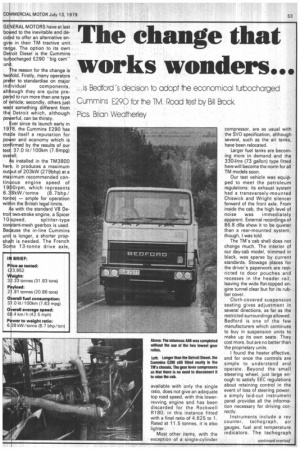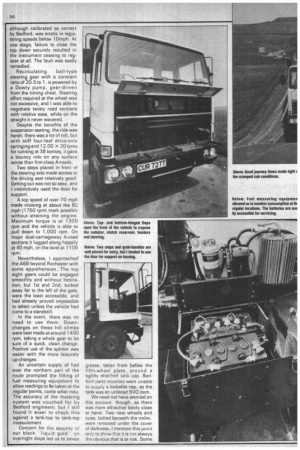The change that works wonders...
Page 55

Page 56

Page 57

If you've noticed an error in this article please click here to report it so we can fix it.
is Bedford's decision to adopt the economical tu ocharged Cummins E290 for the TM. Road test by Bill Brock. Pies, Brian Wea erley
GE ERAL MOTORS have at last bo ed to the inevitable and decid d to offer an alternative engi e in their TM tractive unit. ra ge. The option to its own De roit Diesel is the Cummins tur ocharged E290 "big cam" un he reason for the change is tw fold. Firstly, many operators pr er to standardise on major in ividual components, alt ough they are quite prepar d to run more than one type of ehicle; secondly, others just wa t something different from th Detroit which, although po erful, can be thirsty.
ver since its launch early in 19'8, the Cummins E290 has ma .e itself a reputation for po er and economy which is co irmed by the results of our tes : 37.0 lit/100km (7.6mpg) ove all.
s installed in the TM3800 hen, it produces a maximum out sut of 203kW (279bhp) at a ma imum recommended contin ous engine speed of 19 Orpm, which represents 6. 8kW/tortne (8.7bhp/ ton e) — ample for operation wit in the British legal limits.
s with the standard V8 Detroi two-stroke engine, a Spicer 10 speed, splitter-type con ..tent-mesh gearbox is used. Be ause the in-line Cummins um is longer, a shorter propsha t is needed. The French So a 13-tonne drive axle, compressor, are as usual with the SVO specification, although several, such as the air tanks, have been relocated.
Larger fuel tanks are becoming more in demand and the 330-litre (73 gallon) type fitted here will become the norm for all TM models soon.
Our test vehicle was equipped to meet the petroleum regulations: its exhaust system had a transversely-mounted Chiswick and Wright silencer forward of the front axle. From inside the cab, the high level of noise was immediately apparent. External recordings of 86.8 dBa show it to be quieter than a rear-mounted system, though. I was told.
The TM's cab shell does not change much. The interior of our day-cab model, trimmed in black, was sparse by current standards. Stowage places for the driver's paperwork are restricted to door pouches and recesses in the header rail, leaving the wide flat-topped engine tunnel clear but for its rubber cover, Cloth-covered suspension seating gives adjustment in several directions, as far as the restricted surroundings allowed. Bedford is one of the few manufacturers which continues to buy in suspension units to make up its own seats. They cost more, but are no better than the proprietary units.
I found the heater effective, and for once the controls are simple to understand and operate. Beyond the small steeering wheel, just large enough to satisfy EEC regulations about retaining control in the event of loss of steering power, a simply laid-out instrument panel provides all the information necessary for driving correctly.
Instruments include a rev counter, tachograph, air gauges, fuel and temperature indicators. The tachograph although calibrated as correct by Bedford, was erratic in registering speeds below 1 Omph. At one stage, failure to close the top down securely resulted in the instrument ceasing to register at all. The fault was easily remedied.
Recirculating ball-type steering gear with a constant ratio of 20.5 to 1, is powered by a Dowty pump, gear-driven from the timing chest. Steering effort required at the wheel was not excessive, and I was able to negotiate twisty road sections with relative ease, while on the straight it never wavered.
Despite the benefits of the suspension seating, the ride was harsh; there was a lot of roll, but with stiff four-leaf drive-axle springing and 1 2.00 x 20 tyres for running at 38 tonnes, it gave a bouncy ride on any surface worse than first-class A-roads.
Two steps placed in front of the steering axle made access to the driving seat relatively good. Getting out was not so easy, and I instinctively used the door for support.
A top speed of over 70 mph made cruising at about the 60 mph (1750 rpm) mark possible without straining the engine. Maximum torque is at 1 300 rpm and the vehicle is able to pull down to 1,000 rpm. On major dual-carriageway A-road sections it lugged along happily at 40 mph, on the level at 1100 rpm.
Nevertheless, I approached the A68 beyond Rochester with some apprehension. The top eight gears could be engaged smoothly and without hesita-. tion, but 1st and 2nd, tucked away far to the left of the gate, were the least accessible, and had already proved impossible to select unless the vehicle had come to a standstill In the event, there was no need to use them. Downchanges on these hill climbs were best made at around 1400 rpm, taking a whole gear to be sure of a quick, clean change. Positive use of the splitter was easier with the more leisurely up-changes.
An uncertain supply of fuel over the northern part of the route prompted he fitting of fuel measuring equipment to allow readings. to be-taken at the regular points, come what may. The accuracy of the metering system was vouched for by Bedford engineers; but I still found it wiser to check this against a tank-top to tank-top measurement.
Concern fer the security of our black "liquid gold'' on overnight stops led us to smear grease, taken from below the fifth-wheel plate, around a tightly attached tank cap. Bedford parts stockists were unable to supply a lockable cap, as the tank was an unlisted SVO item.
We need not have worried on this account, though, as there was more attractive booty close at hand. Two new wheels and tyres, bolted beneath the trailer, were removed under the cover of darkness. I mention this point only to show that it is not always the obvious that is at risk. Some people will steal anything that can be moved.
The day of our track test was dry with little wind. Maximum brake applications produced an overall stopping distance marginally lower than average from 40 mph, which might have been reduced by almost 4 per cent but for a short delay in the system. It was stable and pulled up without wheel lock.
Acceleration times are particularly quick; less than 70 seconds to reach 50mph from rest. The well-matched gearing was a major contribution to the fast overall journey times.
On most occasions I used 3rd gear to move off, missed fourth out, and instead selected fifth. From then on, full use was made of the split gears up through the box. The splitter switch, mounted on top of the gear stick, was most conveniently placed. A hill restart could be made comfortably on a 1 in 5 gradient by using the lowest gear ratio.
Ample glass on all sides included a deep front screen to provide for excellent all-round vision. Sun-visors above the screen enclose two recesses in the header rail. Perforated side blinds are also a good idea, but tend to obstruct the view through the rear-view mirrors, most noticeable on the nearside of the cab, where it is out of reach from the driving seat.
Engine access is below the all-steel cab, which can be raised through 60 by using a hydraulic pump mounted at the rear. There is no need to disconnect the gear lever, as it compresses out of the way. The self-securing safety catch was very stiff and could not be released without a considerable effort. Two front flaps across the full-width cab hinge free, so that daily servicing of coolant and oil can be made with the minimum of hindrance. Heaters, steering, compressor and clutch-fluid reservoir can also be reached from this point.
Summary
Outwardly the TM cab looks big, but inside it is cramped and lacks the fine trimming of a topof-the-range model. The exhaust, fitted across the front, is noisy. The in-house seats are the best pieces of cab equipment, but may be replaced soon by proprietary units.
The Cummins engine, Spicer 10-speed gear box and Rockwell axles come together to make a well-matched drive line. Fast journey times and a good fuel consumption is a combination sought by most manufacturers, but riot always achieved as well as it has been here. A Fuller gear box could be made available if there is sufficient demand.
Priced at £23,852 with fifth wheel and wings, it could prove to be more economical than initially cheaper and less powerful alternatives. Despite its bouncy ride, it will be popular among drivers for the way in which it drives. Contrary to the current statements in favour of the Detroit engine, this one looks to be more economical.








































































































































